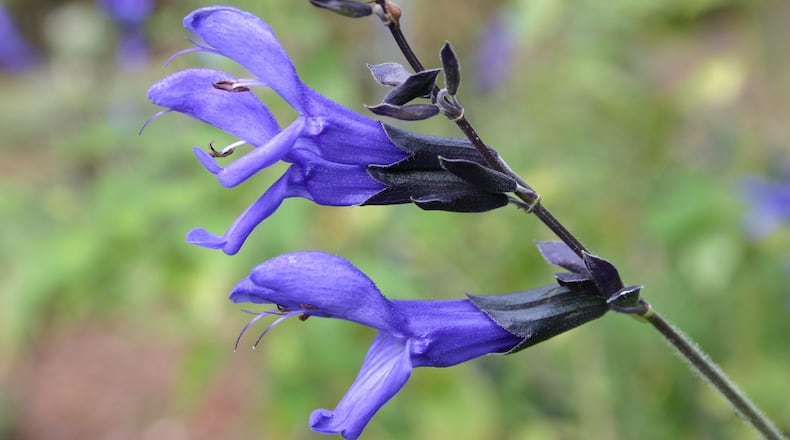Shrubs and trees might be the backbone of home landscaping, but perennials can turn that foundation into a garden.
Perennials are plants such as hostas that die back to the ground every winter and then return the next spring from their roots to grow and bloom during the spring, summer or fall.
With thousands of varieties and literally hundreds of new introductions each year, how do you decide which are right for your garden?
I took that question to Sara Henderson, volunteer chairwoman of the landscape committee at Oakland Cemetery — an Atlanta public park and a good place to look for plants that are tough and can survive with little attention.
“Oakland Cemetery is a challenging place to garden,” Henderson said. “There’s not a large staff to groom or pamper plants, but we need them to look good throughout many seasons. The plants have to be tough, able to take care of themselves and perform.”
Spring blooms in sun
Henderson first mentioned bearded iris, Iris germanica. “With the right drainage and good air circulation, many of the older varieties will do well,” Henderson said. “ ‘Immortality’ is an old-fashioned variety that will offer several flushes of bloom.”
She also likes Siberian iris, Iris sibirica, which blooms freely, multiplies easily and adapts to a wide variety of conditions, including a little more damp and a little more shade than its bearded cousins. She recommended ‘Caesar’s Brother,’ although she also said she never met a Siberian iris she didn’t like.
An aptly named iris that has done well at Oakland is Iris x albicans, ‘Cemetery White,’ one of the earliest spring bloomers.
Other choices: wild blue phlox, Phlox divaricata; Dianthus gratianopolitanus ‘Bath’s Pink’ and ‘Firewitch’; and false indigo, Baptisia australis.
Summer blooms
Veronica ‘Goodness Grows’ has been a terrific performer at Oakland. “We had great heavy bloom early in the season and then the plants bloomed again nonstop until we saw the flowers frozen to mush,” Henderson said.
Phlox was a Victorian favorite, perfect now for Victorian-era Oakland. Phlox paniculata ‘David’ offers plants 3-feet tall with big heads of fragrant white blooms. “This phlox has been very long blooming for us at Oakland, with the big initial bloom followed by side shoots that continued the flowers for many weeks,” she said.
Other choices: Clematis integrifolia ‘Arabella’; Arkansas blue star, Amsonia hubrichtii; daylilies; and purple coneflower, Echinacea purpurea.
Fall blooms in sun
Goldenrod is an Oakland stalwart — tough plants that look good through the spring and summer and then burst into bloom in the fall. Henderson likes Solidago rugosa ‘Fireworks’ for September bloom and Solidago sphacelata ‘Golden Fleece’ for October flowers. “These varieties will multiply, but they don’t take over like the wild ones, and their blooms are such a great color that complements fall foliage so well,” she said.
Other choices: Korean mums and the world of asters, including Symphyotrichum oblongifolium ‘Raydon’s Favorite,’ ‘Fanny’ and Symphyotrichum laeve ‘Bluebird.’
Shade, partial shade
A good bloomer for the partially shaded garden is the Japanese anemone. Depending on the variety, flowers begin appearing in September and continue for several weeks. Some of the historical varieties like Anemone x hybrida ‘Honore Jobert’ and ‘Whirlwind’ grow to 3-feet tall, and will bloom heavily if given morning sun.
“Most perennials for shade are not going to have ‘wow’ color,” Henderson said. “Flowers in the shade garden have to be looked on as icing on the cake. The bulk of the interest and beauty is going to be the varying shades of green, leaf textures and form of the plants. This can be as interesting as flowers and definitely much longer lasting.”
Although there’s not a great deal of shade at Oakland, in Henderson’s own garden, hostas and hellebores have thrived. Northern maidenhair fern, Adiantum pedatum, looks delicate with its wiry black stems and delicate green foliage, but it’s tough and provides a wonderful contrast to the sturdier hosta and hellebore leaves.
Other choices: Variegated Solomon’s seal, Polygonatum odoratum; autumn fern, Dryopteris erythrosora; and coral bells, Heuchera villosa.
Sprinkle some annuals
Not content with 20 choices, Henderson added one more group to the list — old-fashioned annuals like cleome and cosmos.
They’re not perennials, but in a sunny garden, they will perform like perennials, she said, by coming back year after year from self-sown seed.
“Our gardening season is just so long that you really need these tough performers to help fill in that long, hot summer gap in the blooming period of our true perennials,” she said.
Learn more: www.georgiaperennial.org.
About the Author
Featured

